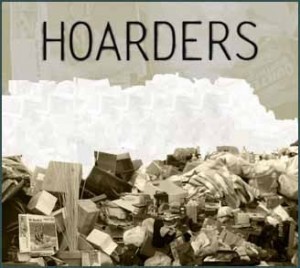Expert: Hoarding TV Programs Can Show How Social Workers, Psychologists Treat Obsession
Television shows that focus on hoarding show the public how severe and dangerous hoarding can become.
However, such programs can also provide an opportunity to highlight what social workers and therapists do to help people overcome the obsession, a leading hoarding expert said.
 These television programs “give people a sense this is a disorder and there is something very wrong here,” said Randy Frost, a psychology professor at Smith College in Northampton, Mass. “On the other hand some of the shows purport to be therapeutic and in fact we don’t do therapy in that way.”
These television programs “give people a sense this is a disorder and there is something very wrong here,” said Randy Frost, a psychology professor at Smith College in Northampton, Mass. “On the other hand some of the shows purport to be therapeutic and in fact we don’t do therapy in that way.”
Frost and National Association of Social Workers member Gail Steketee, the dean and a professor at the Boston University School of Social Work, were among the first researchers to study hoarding more than a decade ago.
Steketee and Frost this year released “Stuff: Compulsive Hoarding and the Meaning of Things” ($27, Houghton Mifflin Harcourt).
Steketee has not watched these programs so did not wish to comment directly on them. However, Frost said he does watch on occasion.
Hoarding programs usually display the piles of clothes, newspapers, rotting food and other material that accumulates in hoarders’ homes and then show counselors going in to help the subjects clean up.
“However, we seldom go in with this interventionist approach,” Frost said. Instead, psychologists and social workers try to help clients realize why they are so attached to their possessions and how to let go.
In fact, Frost said he has had to train therapists to resist the temptation to go into a hoarder’s home and immediately start throwing things in the garbage bin. “That does not change the person,” he said. “We have to teach them to look at possessions in a different way.”
Frost said “Hoarding: Buried Alive” on Sundays at 9 p.m. on TLC is an exception because it sometimes shows what happens in therapy.
“I did the first show before it was a series and they took great pains to show some of what we do in treatment,” said Frost, who added the program may have changed its format so less treatment is shown.
This is a different approach from “Hoarders” on Mondays at 10 p.m. Eastern A&E, which Frost said appears to try to solve the hoarder’s problem in just one weekend.
Hoarding is still a mysterious disorder. Frost and Steketee are unsure what kind of family dynamics are involved but trauma is often linked to hoarding. And as people grow older they may get more attached to items that spark fond memories and lose mental skills that help them organize, categorize and make decisions about all the objects they have accumulated over a lifetime
“As people get older and they lose these skills hoarding takes over,” Frost said.
In fact, about 2.5 percent to 5 percent of the population suffers from hoarding but the number of hoarding cases is expected to grow as the nation’s population grows older.
Another thing to remember is that hoarders come in all ages, Frost said. This may indicate that hoarders are people whose brains are wired in such a way that they look at the physical world differently.
“They pay attention to colors and details that get associated with a memory in a different way than most people,” Frost said, explaining that hoarders may get the same nostalgic feeling from holding an object that some people get from listening to an old song they loved.
Animal Hoarding Needs Even More Study
The causes of animal hoarding as shown on Animal Planet’s “Confessions: Animal Hoarding” are even harder to determine because it is difficult to find people who are willing to come forward and be researched, Frost said. That is because people who keep dozens of dogs, cats, horses or other animals are often pilloried in the press and do not want more attention.
“As far as we know (animal hoarding) looks similar to other hoarding but there are a couple of differences,” Frost said. “The nature of the attachment to the animal appears more rigid although that point is arguable.
“There is a bit more denial — they can look at a roomful of sick and dying animals and say nothing is wrong which makes it appear delusional in a sense.”
Such television shows would benefit from showing how therapists and social workers actually treat hoarding although that process probably won’t lend itself to a 30-minute or hour-long time slot, Frost said.
“It might be a little more boring,” he said. “That’s not going to help the TV show. The show gets its mileage from emotions.”
QUESTION: Social workers, how do you help clients overcome hoarding? Is the disorder difficult to treat? Leave comments below.
Want to learn more about hoarding? Click here to go to NASW’s “Help Starts Here” consumer Web site to read Gail Steketee’s article, “Obsessions and Compulsions Current Trends — Compulsive Hoarding Q&A.”
| Leave A Comment
Advertisement
11 Comments
Leave a Comment
You must be logged in to post a comment.





My only experience clinically with hoarding was with children and teenagers who had experienced sexual and emotional abuse while living with a parent and the parent’s significant other. The children were in foster care and were hoarding mostly food.
Treating these children was aimed at trying to help them develop trusting and supportive relationships with their foster families and with their therapist. We worked with the foster parents to help them understand that the hoarding was part of the child’s issues with attachment and what had happened to him/her prior to coming into the foster home.
It was a long and difficult road for the child, the foster family and the therapist. Hoarding is a very complex problem and needs to be treated with sensitivity in each unique situation.
These deep seated problems are not given the time and depth of understanding in a 30-60 minute television show which is focusing on the sensational aspect of hoarding. I believe that it creates more misunderstanding than anything else.
I would hope that they offer continued emotional treatment for their subjects, only in this way could I ever justify such a show.
I agree that treatment must be based on the underlying motive. Hoarding is a different experience for different people and the current DSM does an unsatisfactory job in discussing it. Hoarding can be a symptom of many different conditions. Although it is commonly associated with OCD, there are some who suffer from hoarding who do not meet any other OCD symptoms. More research is needed in order to develop evidence based interventions.
Hoarding is a very difficult problem for people to overcome and typically requires intensive treatment. Many seniors I have worked with love their possessions and are afraid to let go of much.
Treatment is based on what the client’s motive is on hoarding. Any obsession is difficult to treat but it can be done with the appropriate assessment. For hoarders obsession, extensive counseling is in order. I definitely agree hoarding is a real problem people get help for and we as social workers should approach it in a respectful way that enables the person to open up. With time they will have the ability to view themselves in such a way that allows them to deal with what it is they are actually holding on to. Find the root of the problem.
I don’t have much experience w/ it but from the one client I worked w/ (and as a non-medical care giver, not a SW) I can say that if the person doesn’t have a good relationship with their family, they seem to depend more on their “stuff” to feel connected to something special.
An individual who has great difficulty in managing their personal space exhibits underlying signs of feeling out of control/lack of power in their personal lives and in dealing with society. A triage system with importance of items treasured with COMPLETE regard, respect, and choice given to the Hoarder is essential. As in any personality/eating/addictive disorders gaining and feeling in control is one of the strong components toward successful treatment.
I try not to get into pop therapy based on television programs.
Sorry Shaw; pop therapy based on televison programs may be the only theory you’ve been exposed to; but please do not minimize a real problem for some folks with real feelings that need a empathetic professional response for treatment…
Well, I have not seen a hoarder in real life. Several slobs yes. If I ever do, I will be sure to be empathetic as usual.
Aside from the obvious planning and assessment needed to properly diagnose, how can we as therapists begin to understand what it would be like for a hoarder to have to let go of one of his collected items. What are they really holding on to? To do that we need to meet them where they are.
It’s important to respect them and all their stuff too. They are used to everyone wanting to throw out their possessions. Helping hoarders is a long process. Baby steps first.